
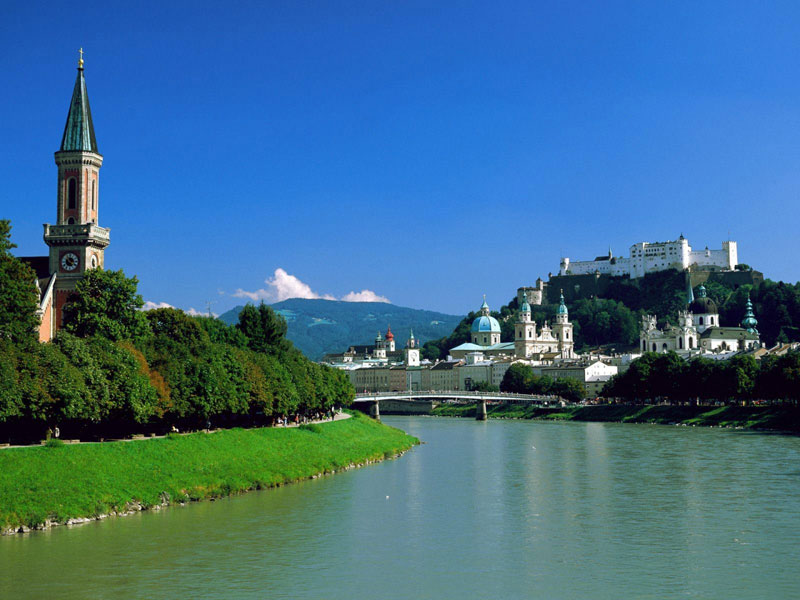
Area: 83.8 thousand km2.Avstriya3
Population: 7.9 million (1998).
The official language is German.
Capital: Vienna (1.5 million, 1998).
National holiday: Day of the law on permanent neutrality (26 October,
1955.).
Currency: Euro.
Member of the UN since 1955, Member of the Council of Europe since 1956,
the European Union - from 1995
A federal state is located in the heart of Europe. Once the core of the
Austro-Hungarian Empire, today - a country adhering to the policy of
neutrality. Birthplace of the great Mozart and the Viennese Waltz, the
center of the ski resorts - all especially attracts tourists.
This small country is situated in the heart of Europe and has no outlet
to the sea. It shares borders with the Czech Republic, Slovakia,
Hungary, Slovenia, Germany, Italy, Switzerland, Liechtenstein. Its
territory stretches strongly narrowed in the west and in the east of the
extended wedge.
Engineering, though, and forms the core of the whole industry in Austria, developed to a lesser extent than in the major industrial countries of Europe. Enterprises in this sector are generally small: the number of workers in many of them no more than 50 people. There was a range of industries, including timber harvesting, processing and pulp and paper. Austria is especially famous for its skiing. For forest products account for about a third of the country's exports. Also developed chemical and garment industry.
Mineral little except magnesite mining which has export value.
In Austria, intensive and high-value agriculture. The leading industry - dairy farming. This contributes to the character of land: the natural grasslands and pastures occupy more than half the agricultural land. In the valleys, located mainly in the Danube of the country, wheat, barley, sugar beets. Some lands are used interchangeably as arable land and pastures. Communications network is quite dense, not only in the plains, but in the mountains. There are more than 10 tunnels, the largest of which has a length of 14 km. From Vienna radially divergent tracks and highways. The Danube is navigable throughout the Austrian section.
Climate in Austria
The climate is temperate in Austria. In the western regions of the
country significantly influence the Atlantic, and in the mountains and
in the east it is more continental. The coldest month is January. On the
plains in winter temperature is mainly slabootritsatelnaya, in the east
of the country - does not drop below 10 degrees, and in the mountainous
areas have temperatures down to -15 degrees. Summer is hot in the east
of Austria, for example, in Vienna in July and August in the afternoon
air is heated to 30 degrees. In the west of the warm summer - daily
temperature reaches 21 .. 23 degrees at night is also noted to +13
degrees. In the mountains in the summer temperatures range from 25
degrees in the daytime to 10 degrees at night. The annual rainfall in
the east of Austria is about 600 mm, and in the West - to 2000 mm.
Basically, they fall in the summer. The mountain snow cover lasts up to
8 months of the year.
The water in local lakes in the summer warms up to +25 .. +27 degrees.
Traditions of Austria
Excessive joy of life
that radiates the Austrians, can cause many foreigners a great love for
the small country in central Europe. It pulls in and the Europeans and
Americans, and Japanese.
Austrians are known for their anxious attitude to cleanliness, comfort
and beauty of their homes. They invest a lot of time and money in their
homes and called the house a second skin. Interestingly, in the
household, regardless of the level of education, welfare, or the size of
living space, many follow the principle of "do it yourself", and not
only men but also women (up to self-repair the roof.) And sometimes it
does not do it because they can not hire workers, and for pleasure.
Great importance in decorating homes, creating the famous Austrian
cosiness. Guests are usually offered ragged slippers, so as not to
violate the purity of the sexes. Children's rooms are usually full of
toys, but sometimes it seems that the main purpose of the latter - to
stand on the shelf, and not serve as a subject for games - they are so
neatly separated.
Family is the most precious in life Austrians.
Most residents of Austria dressed well and elegantly. But this is not
the only feature of the Austrian style: in this country, perhaps, only
in the West, yet still wear the traditional national costume ("Trachten").
And it is immediately apparent when looking at the clothes the crowds.
Of course, mostly modernized things, but they are still a great breath
comes the good old days. Moreover, the national costume of yesterday
becomes the fashion of today. Cute "Dirndl" (long dress with puffed
sleeves and apron) or elegant men's jacket gray with green trim are now
indicators of good taste and emphasize individuality.
Austrians are able to create for themselves and for visitors holiday
atmosphere. In addition to statutory holidays, in every major city or
region of Austria celebrate their own.
Attractions in Austria
Vienna Ball
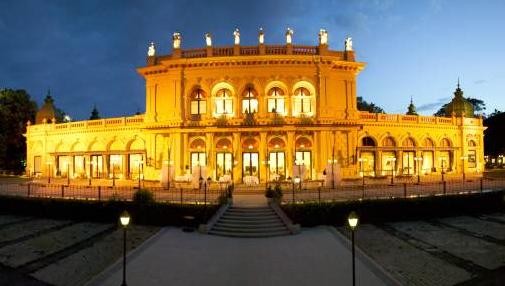 Season opens balls famous
Imperial Ball at the Hofburg Palace, which attracts tourists from all
over the world. More than six thousand visitors already on the main
staircase meet with the "masters" of the ball (in the costumes of
Emperor Franz Joseph and his wife Elizabeth) and immediately get into
the atmosphere of the Habsburgs - a solemn and majestic. As in all of
the Viennese balls are sure to hear waltzes by Johann Strauss, although
in different rooms of the Hofburg play several orchestras and you can
choose to dance: samba, tango, rumba or rock-and-roll. The tradition of
the Viennese balls is relatively new, but their duration is associated
with ancient festivals: the Roman Saturnalia and Europe to winter:
Carnival, or "phishing," as it is called here. To the XVIII century in
Vienna and other European cities Carnival accompanied by mass carnivals.
Often under the guise of the fun of carnival costumes and masks took
stormy, festivities often ended in fights and even murders.
Season opens balls famous
Imperial Ball at the Hofburg Palace, which attracts tourists from all
over the world. More than six thousand visitors already on the main
staircase meet with the "masters" of the ball (in the costumes of
Emperor Franz Joseph and his wife Elizabeth) and immediately get into
the atmosphere of the Habsburgs - a solemn and majestic. As in all of
the Viennese balls are sure to hear waltzes by Johann Strauss, although
in different rooms of the Hofburg play several orchestras and you can
choose to dance: samba, tango, rumba or rock-and-roll. The tradition of
the Viennese balls is relatively new, but their duration is associated
with ancient festivals: the Roman Saturnalia and Europe to winter:
Carnival, or "phishing," as it is called here. To the XVIII century in
Vienna and other European cities Carnival accompanied by mass carnivals.
Often under the guise of the fun of carnival costumes and masks took
stormy, festivities often ended in fights and even murders.
This situation did not suit the Austrian empress Maria Theresa, and her
orders were established rules governing the conduct of phishing.
Prohibits the wearing of masks, the holiday was moved from the streets
to the palaces, strictly limited number of guests (the common people had
no choice but to move to as pubs and taverns). Only during the reign of
Maria Theresa's son Joseph II of the limitations was lifted. Balls in
the Hofburg are available to all (except service), it was again allowed
to hide under the guise of a person, but only in the halls of the
palace. Dancing under the roof quickly supplanted street festivals, and
refined atmosphere balls became distinguished Vienna from other European
cities, where reigned Shrovetide week folksy spirit of carnival.
Every Viennese ball has its own mood and unique character. Plays a
significant role preserved medieval guild since the Viennese spirit of
corporatism. His balls organize lawyers and doctors, and the driver's
cab owners of cafes, firefighters and officers, mechanics and the local
Roma, hunters and students ... The ball hunters traditionally come in
the Austrian national dress: Dresses �Dirndl� and costumes of green
cloth �Loden�. The ball-Rudolfina redoubt, held at the Hofburg Palace in
1910, the Catholic Union of Students, young people are in the yellow,
magenta, green, orange, blue, red berets ... Here is going to college
and university youth from all over Austria, and the colors represent
berets belonging to various student associations. Another tribute to the
history - an indispensable lottery and gifts to the guests of the ball.
What these souvenirs were before, you can see on the stands Strauss
Museum in Vienna - brooches, fans, a toy train, a medallion, icon,
miniature books in an iron chest, ball notebook with a pencil ... Today,
guests want to have a souvenir of the evening on. At the ball, gardeners
ladies receive a free flower, and if you are lucky in the lottery -
indoor plant in a pot, the ball Furriers prize - a mink coat, the ball
confectioners choose the "queen of the evening" and solemnly handed a
bag of sweets and cakes, equal to its own weight .. . Protection Each
year the organizers are making some innovations - changing motto or
crown of the ball, decorations, gifts. This year, the owners of Viennese
cafes chosen for your prom theme of "France in Vienna", and the halls of
the Hofburg are going to transform the traditional Viennese coffee
house. At the ball, guests will bake pastry for three thousand cakes.
St. Stephen's Cathedral
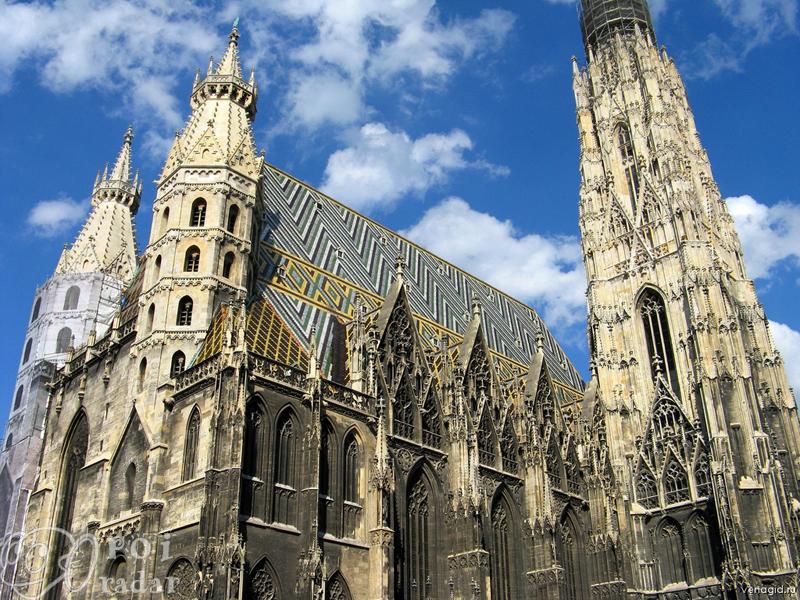
ST. Stephen (in fact,
"the cathedral church of St. Stephen in Vienna"), who lovingly called
crowns Steffl, is one of the symbols of the capital of Austria and is
located at the very center. Since 1569 the cathedral is the seat of the
Archbishop and the most important Gothic structure of the alpine
republic.
First Romanesque church on this site dates back to 1147, which is often
rebuilt and reconstructed (1263, 1394-1340, 1359, 1640). Wars and fires
also cause serious damage, example - a fire in the last days of World
War II, after which the restoration work carried out even today.
South Tower. Cathedral has a length of 107 meters and width - 37 pm
There is also another part of the late-preserved buildings from 1230.
Cathedral surrounded by four towers, the tallest is the South Tower (Südturm)
- 136,4 m, the north tower was not completed, and its height is "only"
68 meters in the former Austro-Hungarian monarchy was forbidden to build
up the church of the south tower of the Cathedral of St.. Stephen.
Example - Mariinsky church in Linz (Maria-Empfängnis-Dom in Linz), the
tower of which was specially built for 2 m below the cathedral in
Vienna. The narrow winding stairs - 343 steps - you can go up to the
observation deck, which offers a wonderful view over the roofs of
Vienna.
In the south tower are 18 bells. Attraction among them is Pummerin (Pumemrin).
First Pummerin was poured in 1711, of the 208-mi Turkish guns (there
were 300), which were left there after the siege of Vienna in 1683. The
bell weighs 22.5 tons and 15 men shook him for 15 minutes until he first
published the ring. The bell rang just 10 times a year. After 230 years
of faithful service in the last days of World War II (April 12, 1945)
ST. Stephen seized fire burned wooden pendants, Pummerin fell down and
broke. In 1951 Pummerin was cast for the second time and now, after the
bells in Cologne (Germany) and Rowenta (Italy), he ranks third in the
list of the biggest bell in Europe and the fifth - in the world.
Pummerin today is in the key of C major, and it is called the "voice of
Austria."
Cathedral inside. Cathedral is a wonderful example of a typical Gothic
style, not only outside but also inside. Here you will hit countless
Gothic sculptures, figures of saints or noteworthy elaborately carved
wooden altar Noyshtadtsky Vienna (1447). One interesting feature of the
cathedral is the figure of Jesus' suffering teeth "(c. 1415). Legend has
it that the three young students mocked Jesus figure and a bandaged
cheek towel, because they thought that he had toothache, and therefore
is suffering face. Soon after, all three felt very acute dental pain,
and realized that it is their statue punished. After lengthy prayers and
requests for forgiveness pain yet passed. Another interesting figure is
the figure of the Madonna - patron saint of servants and messengers (Dienstbotenmadonna,
ca. 1325), which belongs to the most famous sculptures of the Gothic.
They say it has helped to justify a single messenger, who was accused of
stealing and asked her for help.
One of the few elements of the baroque cathedral - the high altar of
black marble, built in the XVII century by famous masters and Johann
Tobias procs.
On tour, you can also visit the famous catacombs - a system of
underground tunnels, which until 1738 had been buried the most important
people of the empire: here you can see the ducal vault with the coffins
and urns of the Habsburg family, the burial crypt Vienna archbishops and
Canonical vault - vault Vienna Canons .
St. area. Stephen (Stephansplatz) along with leading to it is one of the
streets of the most beautiful architectural ensembles of old Vienna.
Here you can see a mixture of styles - from the Gothic and Baroque to
modern. It is also the largest cab parking in Vienna. By the way the
first license for this business was issued in the Austrian capital in
the distant 1693, and in 1790 in Vienna, has been more than 700 wagons.
Today, there are just over 100 cab, whose driver must pass a special
exam. Price wagon rides depends on the duration - from 40 to 65 Evreux,
and the cab is designed for the highest five passengers.
Cities in Austria
Vienna
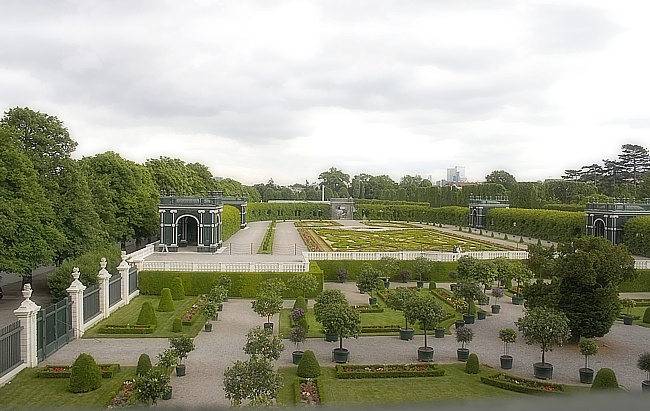 Vienna is
considered one of the most charming cities in Europe. Former capital of
the Austro-Hungarian Empire, Vienna impresses with its grandeur and
luxury, charm and warmth ... This is an extremely diverse city. Vienna
is rightly called the heart of Europe. In this beautiful city, you will
not have to leave the holiday feeling, whenever you have not visited in
the summer or winter.
Vienna is
considered one of the most charming cities in Europe. Former capital of
the Austro-Hungarian Empire, Vienna impresses with its grandeur and
luxury, charm and warmth ... This is an extremely diverse city. Vienna
is rightly called the heart of Europe. In this beautiful city, you will
not have to leave the holiday feeling, whenever you have not visited in
the summer or winter.
Vienna - a city of magnificent palaces, grand squares, picturesque
streets. The city on the Danube, surrounded by a green necklace Vienna
Woods. A city of poets and musicians, the city is brilliant, but cozy,
cheerful and thoughtful. The city is amazing and timeless ... Vienna -
two millennia Great stories. Thanks to art galleries, concert halls and
the famous Vienna Opera, Vienna became the cultural center of Europe.
Regardless of the season, evening Vienna turns into one of the most
beautiful cities in Europe. Cultural life is poured into an opera and
concert halls. Restaurants in the city offer plenty of choice - from
small local cafes to major restaurants for gourmets and connoisseurs of
special dishes. In Vienna, many night clubs, discos and casinos, which
are open to the public until the morning.Vienna is similar to St.
Petersburg and Moscow at the same time, people have been slow, but come
on time, gold stuffy imperial pomp gets on with foolishness eclecticism
per answer, but most importantly - radialnokrugovaya Circuit City does
not prevent straightness of the streets. So walking is very convenient
in the center - is a must. You should start with a walk around the first
district in the ring Ringstrasse. Bikes are not a problem rolling
stations a dime a dozen, but with the iron horse is more difficult to
spend money in local stores like vintage shops Eselmist or fashion mall
2006FEB01. By the way, keep in mind, the shops are closed on Sundays and
public holidays (in winter - December 25 and 26, 1 and 6 January), and
the working day ends no later than 19.00. But public transport in Vienna
goes anywhere around the clock. So it makes sense to break into licked
the outskirts, they too do not lack monuments. And you do not want to
leave the center and in the gardens of Schönbrunn, paradoxically, can
also get rid of the tourists.
Salzburg
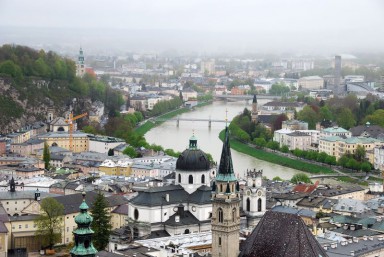 The fourth
largest city in Austria, but the beauty and historical significance may
well compete with Vienna, and this is clearly evidenced by the great
number of tourists every year who come here: the season the number of
tourists in the city far outnumber the local population. In 1997,
Salzburg was included in the UNESCO list of monuments of historical
heritage. Salzburg has a remarkably beautiful location - on the northern
edge of the Alps. From the south to the city right fit pretty high
mountains, it can be seen even top-dvuhtysyachnika and in the north
hilly plain.
The fourth
largest city in Austria, but the beauty and historical significance may
well compete with Vienna, and this is clearly evidenced by the great
number of tourists every year who come here: the season the number of
tourists in the city far outnumber the local population. In 1997,
Salzburg was included in the UNESCO list of monuments of historical
heritage. Salzburg has a remarkably beautiful location - on the northern
edge of the Alps. From the south to the city right fit pretty high
mountains, it can be seen even top-dvuhtysyachnika and in the north
hilly plain.
The main charm of Salzburg - Baroque architecture of the Old Town, most
of which relates to the pedestrian area. In the historical part of the
city preserved many old churches and houses, here is the many small
boutiques, where every thing is unique.
Salzburg - the birthplace of Mozart, and is often said that the great
composer could only be born here - in a magical and colorful
surroundings of this ancient city. Every year, in late January, is held
in Salzburg Mozart Week, here gathers the musical elite to enjoy the
magical music. It also celebrated the two hundred and fiftieth
anniversary of Mozart's birth - on this day, January 27, started to ring
the bells of all the churches 35 years of Salzburg, in memory of the
great son of the city.
In addition, Salzburg and its surroundings were a film set for the
beloved film "The Sound of Music." The lens cameras were almost all of
the major attractions of the city. Now organized a special tour of the
city and its suburbs with a visit to the famous movie locations. By the
way, watching the movie is fine for a first acquaintance with the beauty
of Salzburg.
Linz
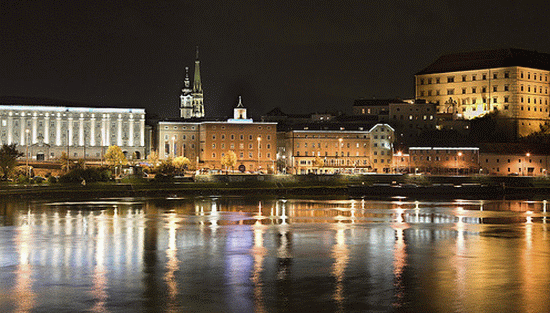 The population of Linz - 185 000. Linz -
the capital of Upper Austria and the third most populous city after
Vienna and Graz. Linz declared the cultural capital of Europe in 2009.
City with dignity is preparing for an extraordinary fireworks for the
grandeur of cultural events. The arrival of more than 2 million
visitors.
The population of Linz - 185 000. Linz -
the capital of Upper Austria and the third most populous city after
Vienna and Graz. Linz declared the cultural capital of Europe in 2009.
City with dignity is preparing for an extraordinary fireworks for the
grandeur of cultural events. The arrival of more than 2 million
visitors.
Stretching in a broad valley on both sides of the Danube city is
mentioned in historical documents as a Celtic settlement Lentos the
Bronze Age. The ancient Romans built a fort here border Lenz in 15 BC
The name of the Linz appeared in 799 year. In 1490, Emperor of the "Holy
Roman Empire" Friedrich III officially declared its capital Linz. After
7 years the city has received permission to build a bridge across the
Danube. Development of the city contributed to its favorable
geographical position on the Danube as an important trade artery. Linz
is today through railway, providing direct transportation links between
the Baltic and Adriatic seas.
Business-hasty
days of modern Linz, harmoniously combining the business life of the
industrialized industrial city in Austria with a rich cultural life and
international events. The city is famous for the famous Bruckner
festival, held annually in September in memory of the masterpieces of
composer Anton Bruckner. This festival is a romantic name "Linz sound
cloud� (Linzer Klangwolke). It opens with a laser show in the Danube
Park and the response to various pieces of music. The sight is awesome!
Another of the exciting events in the city - Electronic Art Festival,
held each year in September, the center of electronic art (Ars
Electronica Center), is a kind of museum that allows visitors to fly
over Upper Austria in the virtual space, marvel at the wonders of
computer animation, graphics and simulation . The festival prize for
achievements in the field of computer art.
Mountain Home Linz - Pöstlingberg. To top of it you can climb the
steepest railway in the world, built in 1898, from Enjoy a magnificent
view of the city, stretching along both banks of the Danube.
Pöstlingberg loved and frequently visited residents of Linz is because
on top of it is the pilgrimage church (Wallfahrtskirche), built in 1738.
Entertaining children's world is located in a fabulous grotovom tunnel
that kids can drive around on "Express dragon." There is also one of the
most beautiful botanical gardens in Europe with a unique collection of
cacti (over 1100 species). This is one of the richest collections of
cacti in Europe.
From Linz linked the names of many historical figures, scientists who
have made significant contributions to science, and prominent figures of
culture and art. Founder theoretical astronomer Johannes Kepler in the
period from 1612 to 1626 he worked in Linz. Austrian painter and writer
Adalbert Stifter also prefer the last 20 years of his life living and
working in Linz.
Very interesting architecture Linz. On Hauptplatts (Hauptplatz, Main
Square) preserved many buildings, monuments, with unusually narrow
(three window openings) out of the square, which leads to higher taxes.
All these buildings have a narrow frontage, but significantly extended
in depth, and to provide a flow of light, many of them are exclusively
decorated courtyards, such as "patio", which are used in the summer for
a cozy chamber concerts.
St. Pölten
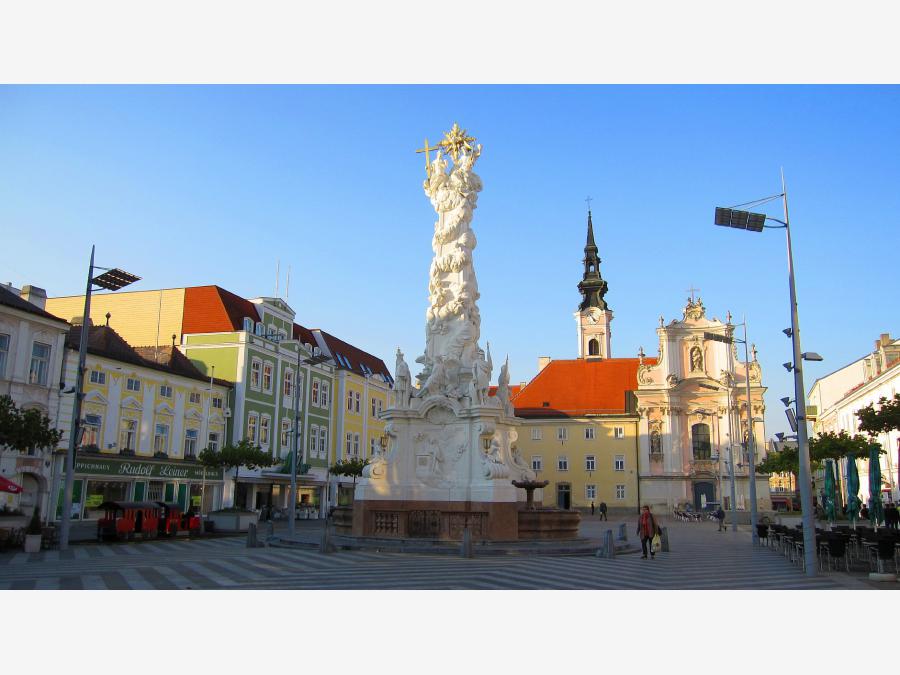 St. Pölten
Trayzen located on the river, 65 km west of Vienna. The city is the
capital of Lower Austria. The territory of the city - 108, 48 square
kilometers, the city is home to about 60 thousand people. The city is
divided into 11 districts, which was established 43 community. The city
is located at the intersection of railways and highways. To get to the
city you can train from Vienna, it will take 40 minutes or from Linz -
50 minutes. The nearest airport is the international airport of Vienna.
St. Pölten
Trayzen located on the river, 65 km west of Vienna. The city is the
capital of Lower Austria. The territory of the city - 108, 48 square
kilometers, the city is home to about 60 thousand people. The city is
divided into 11 districts, which was established 43 community. The city
is located at the intersection of railways and highways. To get to the
city you can train from Vienna, it will take 40 minutes or from Linz -
50 minutes. The nearest airport is the international airport of Vienna.
St. Pölten is the youngest and the oldest capital city of Austria. In
Roman times to the site of the present St. Pölten was a Roman city Elium
Tsentium. St. Pölten began to form in the 18th century around the
Benedictine abbey. Right to the City, he received in 1159. Since 1785,
the city was the center of a bishopric, and in 1986 became the capital
of Lower Austria.
Tourist city is beautiful Baroque buildings and picturesque squares. The
old part of the city you will find the column of the Holy Trinity, which
is located in the heart of Old Town Square. Here you can see the
Franciscan Church and the Town Hall, which has repeatedly rebuilt.
Around the square there is burghers houses with baroque facades. In
Cathedral Square is the Cathedral, whose bell tower height is 77 meters.
Front of the church during the summer organized open-air concerts. The
city has several museums: the Diocesan Museum, City Museum, the
Historical Museum of Lower Austria and the Museum of Hof. City Museum is
located in the former convent of the Carmelites, and the Diocesan Museum
is located in the former residence of the bishops. The castle Pottenbrun
you can see a collection of medieval goblets. In the south-eastern part
of the St. Pölten is government district with modern architecture. This
quarter is the Land Museum, Center for Austrian Radio, House of
Parliament of the land, the Festival Palace, land records and Regional
Library. In the neighborhood you can visit the palace Shallaburg, Abbey
Hertsogenburg, museum episcopate Bischofshofen, Lilienfeld monastery.
Especially for tourists excursions to the mountain and the valley
Foralpenland vineyards of the Wachau.
Feldkirch
 Feldkirch
- old Austrian city in the west, in the federal state of Vorarlberg.
Situated on the River Ill, a tributary of the Rhine, in the southern
part of the broad valley of the Upper Rhine. Feldkirch is the most
western city of Austria, he is only three kilometers from the border
with Liechtenstein. Population of 32,341 people in 2008. Feldkirch - the
second largest city after Vorarlberg Dornbirn, surpassing the population
of the capital of the province - Bregenz. Administratively, the city is
divided into seven districts.Feldkirch small given the world many great people. Here was born the
theoretic (Rhaeticus, real name - Georg Joachim von laukh, 1514-1576) -
famous German astronomer and mathematician, and disciple of Copernicus.
Painter and graphic artist of the Renaissance, one of the main
representatives of the Danube School Wolf Huber (c. 1485-1553) - also a
native of Feldkirch.Feldkirch is a fairly well-known winter and summer resort.
Feldkirch
- old Austrian city in the west, in the federal state of Vorarlberg.
Situated on the River Ill, a tributary of the Rhine, in the southern
part of the broad valley of the Upper Rhine. Feldkirch is the most
western city of Austria, he is only three kilometers from the border
with Liechtenstein. Population of 32,341 people in 2008. Feldkirch - the
second largest city after Vorarlberg Dornbirn, surpassing the population
of the capital of the province - Bregenz. Administratively, the city is
divided into seven districts.Feldkirch small given the world many great people. Here was born the
theoretic (Rhaeticus, real name - Georg Joachim von laukh, 1514-1576) -
famous German astronomer and mathematician, and disciple of Copernicus.
Painter and graphic artist of the Renaissance, one of the main
representatives of the Danube School Wolf Huber (c. 1485-1553) - also a
native of Feldkirch.Feldkirch is a fairly well-known winter and summer resort.
In winter, the surrounding slopes and ski resorts will deliver no less
pleasure than the most prestigious resorts in Europe, and in the end of
June, guests can visit the Feldkirch Schubertiade music festival. One of
the main attractions of the city - a tiny zoo, rather the reserve
because the animals are almost naturally, almost without walls and
racks, just 1 km away from the city center. The mountains surrounding
the Feldkirch found chamois, roe deer, red deer, mountain goats,
raccoons, weasels, stone martens, on the plains - hares, foxes, near
water - otter. Avifauna includes grouse, partridges, quails, cranes,
woodcock, snipe, heron, bittern, geese, grouse, mergansers, jays, wood
pigeon, robins, eagles, and so on. In reservoirs bred trout, grayling,
chub, carp.